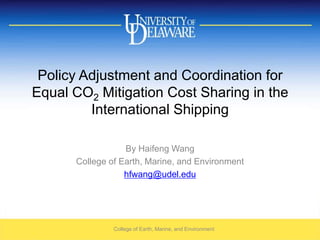
Presentation in APPAM
- 1. Policy Adjustment and Coordination for Equal CO2 Mitigation Cost Sharing in the International Shipping By Haifeng Wang College of Earth, Marine, and Environment hfwang@udel.edu College of Earth, Marine, and Environment
- 2. Background Ships emitted about 1067 million metric tons of CO2 in 2007 This is 3.3% of total CO2 emissions The sixth largest if ship industry were a country, exceeding Germany Policy options have been developed and discussed under International Maritime Organization (IMO) The Marine Environmental Protection Committee (MEPC) The first MEPC meeting targeting at CO2 was in 1996 The latest: MEPC 59 in July, 2009 The Updated 2000 IMO GHG Study The Kyoto Protocol: Shipping Emissions to IMO and Aviation Emissions to ICAO College or Department name here 1
- 3. From Corbett and Winebrake, 2008 College of Earth, Marine, and Environment
- 4. Background: Policy Options The recent debate in MEPC (March, 2009, July, 2009) Available Policy instruments: Emission Trade System (open and closed ETS) International Compensation Fund (ICF) Energy Efficiency Design Index (EEDI) Energy Efficiency Operational Index (EEOI) Ship Energy Management Plan (SEMP) Interim and voluntary package under IMO to reduce vessel-source emissions Voluntary EEDI and EEOI No binding commitment to reduce emissions To be discussed in MEPC 60 in March, 2010 College of Earth, Marine, and Environment 3
- 5. Background: Legal Debate Common but Differentiated Responsibility (CBDR) vs Equal Treatment for All Ships Developing countries: The fuel consumption from ships should be deemed as “Survival Emissions” Developed countries should be responsible for most emissions emitted by ships Developed countries: Equal treatment is the principle of IMO itself Most registered fleets have been already in developing countries (Flag of Convenience) College of Earth, Marine, and Environment 4
- 6. Climate Policy After Kyoto Who will take the lead in Ship-based GHG reduction after Kyoto? International Maritime Organization or A universal GHG reduction regime What will happen in next MEPC meeting in IMO London, March, 2010 Some stakeholders are not content with the progress in IMO EU threatened to act alone if IMO failed to regulate Voluntary approach may not reduce enough GHG College of Earth, Marine, and Environment 5
- 7. Aim of this research Calculates the cost for CO2 reduction policies. Computes the reduction cost impact on the global trade Discusses the policy coordination and cooperation among different International organizations College of Earth, Marine, and Environment 6
- 8. Methodology Activity-based method to estimate the CO2 emissions for Annex I and non Annex I countries Identify all targeted ships Calculate their annual fuel consumption based on engineering models Estimate the CO2 emissions from those ships Calibrate the ratio between CO2 reduction cost and trade cost based on Trade, Ship empirical movement, Ship parameters, and origin-destination Pairs (TSSP) Limit the research in North America College of Earth, Marine, and Environment 7
- 9. College of Earth, Marine, and Environment 8
- 10. College of Earth, Marine, and Environment 9
- 11. Key Assumption: To achieve 20% CO2 reduction, the mitigation cost is between $0-120 per ton. College of Earth, Marine, and Environment 10
- 12. Data Trade, Ship empirical movement, Ship parameters, and origin-destination Pairs (TSSP) Trade: Import Waterborne Data Bank Ship Empirical Movement: Entrances and Clearances by Army Corps of Engineering Ship Parameters: Lloyds shipment register dataset Origin-Destination Pairs: Entrances and Clearances by Army Corps of Engineering Distances between ports: On-line Port2Port Calculators College of Earth, Marine, and Environment 11
- 13. College of Earth, Marine, and Environment 12
- 14. Results College of Earth, Marine, and Environment 13
- 15. The CO2 emissions and costs of some major Non-Annex I countries and maritime states * Exclude fleets registered in Taiwan but include fleets registered in Hong Kong and Macao College of Earth, Marine, and Environment 14
- 16. Countries with highest CO2 cost/import value rate *Countries or territories are not non-Annex I either College of Earth, Marine, and Environment 15
- 17. Policy Implications Small countries are losers in CO2 reduction policies Highest CO2 reduction/trade value ratio Diseconomy of scale They are victims of global warming too Sea level rise Climate change That means policy cooperation and coordination among countries and international organizations College of Earth, Marine, and Environment 16
- 18. Policy Cooperation and Coordination International Maritime Organization CBDR: Countries have to reduce the emissions The payment is collected by an supervisory body Rebate the cost back to small developing countries World Trade Organization Special Tariff reduction Special treatment for small developing countries Environmental Exception for ships? College of Earth, Marine, and Environment 17
- 19. College of Earth, Marine, and Environment 18 Thank You 谢谢 Thoughts or Comments?
Notas del editor
- The preamble of the UNFCCC acknowledges “that the global nature of climate change calls for the widest possible cooperation by all countries and their participation in an effective and appropriate international response, in accordance with their common but differentiated responsibilities and respective capabilities and their social and economic conditions” (UNFCCC 1997).
- GATT Article XX on General Exceptions lays out a number of specific instances in which WTO members may be exempted from GATT rules. Two exceptions are of particular relevance to the protection of the environment: paragraphs (b) and (g) of Article XX. The measure needs to be either:necessary for the protection of human, animal or plant life or health (paragraph (b)) or relating to the conservation of exhaustible natural resources (paragraph (g)).
